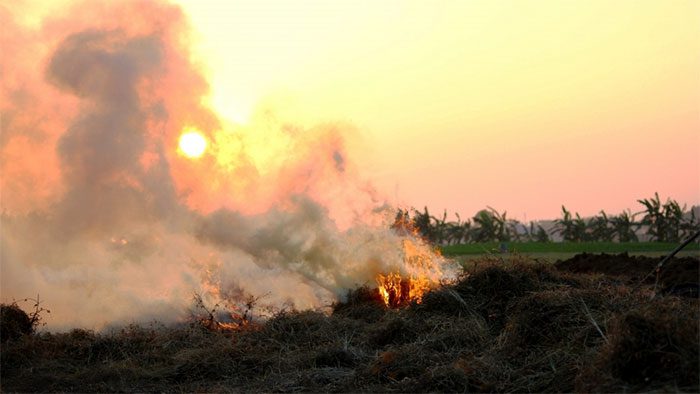In addition to weather conditions and factors from traffic, construction, and production, the burning of straw is a significant contributor to the severe air pollution experienced in Northern Vietnam in recent days.
Air pollution continues to trend upward in Northern provinces in recent days, with air quality on the morning of November 8 remaining predominantly at purple levels (very harmful to health), according to the PAM Air air quality monitoring system. In the afternoon and evening, air quality did not improve significantly, generally remaining at red levels (harmful to health). Pollution is not only concentrated in urban areas such as Hanoi and Thai Nguyen but also appears in several provinces like Hung Yen, Hai Duong, Thai Binh, and Nam Dinh.

The activity of burning straw is considered a significant cause of air pollution in Hanoi in recent days
According to a representative of the Ministry of Natural Resources and Environment, air pollution in Hanoi and urban areas originates from emissions from traffic, construction, industrial production, and other daily activities. The air pollution situation in Northern Vietnam is also heavily influenced by weather patterns. Severe air pollution in the North typically occurs during the winter months, from October to March of the following year, when there is little rain and temperature inversion conditions are present.
Specifically regarding the ongoing air pollution episode, in addition to the aforementioned causes, there is also a contribution from straw burning after harvest, according to Dr. Hoang Duong Tung, Chairman of the Clean Air Network Vietnam. Dr. Tung noted that a large amount of dust is generated from straw burning activities, combined with calm weather conditions that prevent dust dispersion, causing it to settle close to the surface and exacerbating air pollution.
Ms. Ha Thanh Huong, Project Manager of PAM Air, shared that the burning of waste and straw in many areas in recent days has been a significant source of internal emissions, along with the characteristic meteorological conditions of the North during this season, leading to severe pollution.
“The spikes in pollution recorded on PAM Air’s measurement system are often related to waste burning and straw burning activities. Air quality at many monitoring points where burning occurs often reaches hazardous levels – the most dangerous level. This shows the harmful effects of burning activities on air quality,” Ms. Huong said.
Massive dust generation from burning activities
The National Environmental Report for 2016-2020 noted that air pollution in Hanoi and Northern provinces is primarily due to dust pollution. Among them, fine particulate matter PM2.5 is considered a deadly pollutant as it can penetrate deep into the lungs, causing various respiratory and cardiovascular diseases, particularly affecting sensitive groups such as the elderly and children.
Research results from the University of Natural Sciences regarding straw burning activities in Hanoi also indicate that the burning process produces many pollutants that adversely affect human health, such as CO, SO2, NOx, NH3, hydrocarbons, PM10 dust, and PM2.5 dust… Notably, the amount of fine particulate matter PM2.5 generated from straw burning activities is substantial.
Researchers have also pointed out that straw burning is a serious environmental issue due to its localized nature, with pollutants concentrated over a short period. Additionally, through diffusion modeling, scientists have recorded the spread of fine dust from straw burning to distant areas.
The report also stated that straw burning can directly affect human health, causing eye irritation, tearing, coughing, sneezing, and even nausea and shortness of breath. Prolonged inhalation of these gases increases the risk of respiratory and cardiovascular diseases.
| In the Winter-Spring crop of 2020 alone, the total amount of straw left in the fields in Hanoi was 384,505 tons. With approximately 20% of that being burned, it generated 179.08 tons of PM10 dust, 163.3 tons of fine PM2.5 dust, and 23,000 tons of CO2, according to the emission inventory report from the University of Natural Sciences regarding straw burning activities in the fields. |



















































